Geschiedenis van de Puzzle Games
1. puzzle games algemeen
Puzzles, brainteasers, crossword puzzles, and games like dominoes,
chess, and Chinese checkers have fascinated humans for centuries,
so it's no surprise that puzzle video games have become one of
the most beloved genres of electronic entertainment. But when
video games first became popular in the late 1970s, there was
no such thing as a puzzle game. Although there were some innovative
titles like Q*Bert's Qubes and Atari Video Cube, the genre began
(and in some ways, ended) with Tetris. It was the originator,
the game by which all future puzzlers have been measured. So,
what exactly is a puzzle video game? There is no strict definition,
but rather a set of loose characteristics and boundaries. Games
of this genre usually involve shapes, colors, or symbols that
must be arranged or organized to form a specific pattern. Sometimes
these objects are fixed, and sometimes they fall from the sky.
In some cases, you don't control objects or characters directly
but instead affect the surrounding environment. Some puzzle games
rely on quick reflexes, while others reward contemplation. What
they all have in common is their emphasis on strategy and thought
rather than random action. Every effort has been made to document
the most popular, innovative, and notable puzzle games, and the
ten best have been chosen based on originality, addictiveness,
and plain old fun. Of course, not every puzzle game ever made
is listed here, but it is my hope that this history will serve
as an introduction for those not familiar with the genre and
as a walk down memory lane for seasoned players. If you're lucky,
you might even learn something.
2. Pre-Tetris (1976-1987)
Although most people consider Tetris to be the first real puzzle
game, several video games from the Pre-Tetris era contained elements
that would later become integral to future puzzle games. While
many games of this era based their gameplay around simplistic
goals like shooting aliens, asteroids, or robots, these protopuzzle
games (a term of my invention) required a little more brainpower.
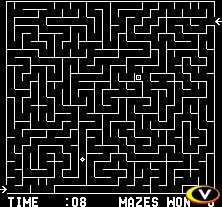 2a. Amazing Maze
2a. Amazing Maze
Released:
1976
Systems: Arcade
While this early arcade game from Midway looks like it has more
in common with Pac-Man than it does with Tetris, it is notable
because it is based on one of the oldest traditional puzzles:
the maze. Without any enemies or weapons, your goal is to reach
each maze's exit before your human or computer opponent does.
That's it. There aren't any ghosts, aliens, or spaceships to
stand in your way. It's just your brain against the maze.
2b. Educational games
Released: 1977-1980
Systems: Atari 2600, Odyssey2
Early video-game systems like the Odyssey2 and Atari 2600 were
advertised as educational tools as well as game machines. Created
to make their systems appealing to more people, not just teenage
boys, most of these education-oriented games, like Othello, 3D
Tic-Tac-Toe, and A Game of Concentration, were based on traditional
games of skill.Sometimes, these educational games were neither
educational nor games. A game like Basic Math, for example, wasn't
fun to play and had limited value as a learning tool. So, what
does all this have to do with puzzle games, you ask? For starters,
these educational games promoted thinking and strategy - essential
to puzzle games - over action and adventure. They also introduced
gamers to the concept that a video game could be set somewhere
other than in space or on a battlefield.
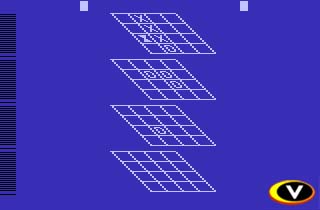
3D Tic-Tac-Toe.
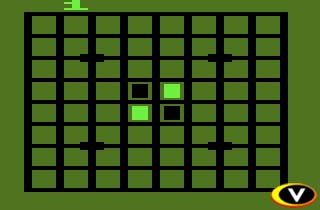
Othello.
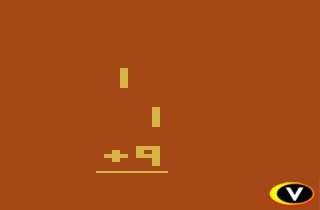
Basic Math.
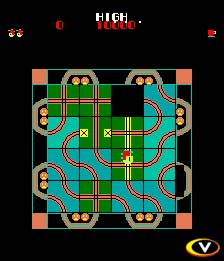 2c. Loco-Motion
2c. Loco-Motion
Released: 1982
Systems: Arcade
In
Loco-Motion, the goal is to guide a train over a set of winding
tracks in order to pick up passengers at each station. What makes
Loco-Motion a puzzle-oriented game
is that you have no direct control over the train. To get the
constantly moving train to go where you want it to go, you must
rearrange pieces of track in the proper order by moving squares
on a grid. Quick thinking and a good amount of strategy will
help you successfully guide your train through the maze of tracks.
You lose a life if you let a train fall into the empty grid square or off the playing area. In addition, watch out for the "crazy train," which appears occasionally and tries to derail your train.
2d. Q*Bert
Released: 1982
Systems: Arcade, Atari 2600, Atari 5200, ColecoVision, Intellivision
Q*Bert
is one of those games that makes no sense on paper but works
perfectly in execution. The title character is an orange long-nosed
creature who hops on a pyramid made of colored cubes and is chased
by multicolored balls and a purple snake named Coily.
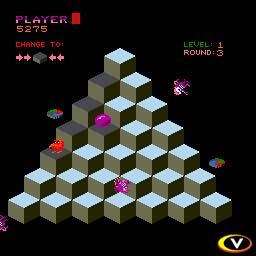
Each time Q*Bert lands on a cube, the cube's surface changes
to a different color. The object of each level is to change the
color of the entire pyramid. On later levels, you must jump on
a cube more than once to achieve the proper color. Falling off
the pyramid causes you to lose a life, as will touching Coily
or one of the nongreen balls. Green balls freeze the action and
allow Q*Bert to jump freely without fear of enemies. Also helpful
are flying disks located on the sides of each pyramid, which
safely whisk Q*Bert to the top of the pyramid.
At first, Q*Bert can be confusing to control because of the pyramid's
pseudo-3D perspective. Though the pyramid is set up on a diagonal,
you will still need to move the joystick up, down, left, and
right to make Q*Bert jump. But once you master the controls,
success is only a matter of timing and skill.
While the abundance of enemies make Q*Bert more of a puzzle/action hybrid than a "pure" puzzle game, Q*Bert introduced a fundamental concept of later puzzle games: color matching.
The
home versions of Q*Bert were excellent, all maintaining the basic
play mechanics of the arcade version. The ColecoVision version
was particularly good, with nearly arcade-perfect graphics and
sound.
3.
Tetris (1988)
In the brief history of video games, there are few titles that can truly be called revolutionary. Among them are Pac-Man, Super Mario Bros., Street Fighter II, Super Mario 64, and, of course, Tetris.
In hindsight, the groundwork for Tetris had been laid by games like Q*Bert's Qubes and Atari Video Cube, but nothing in the past had prepared gamers for the simple brilliance of Tetris. Created and designed by Russian Alexey Pajitnov in 1985, the game first appeared on American shores on the PC in 1987 and in arcades in 1988.
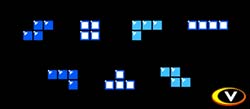
But it wasn't until 1989 that Tetris fever really began to set
it. That was when Nintendo introduced the Game Boy, its portable
game system. The pack-in cartridge? Tetris. The two were a perfect
match - Tetris worked perfectly on the small black-and-white
screen and introduced millions of people (more than 30 million)
to the wonders of Tetris.
Simplicity and addictive gameplay contributed greatly to the almost universal popularity of Tetris. The game is based on a traditional puzzle game named Pentomino, and the object is to arrange and rotate falling blocks into lines without any gaps. Each complete line you make disappears from the game area while lines with gaps remain. When incomplete lines fill up the entire game area, the game is over.
The name Tetris itself comes from the Greek word "tetra," which means four. The significance of the name for the game is that four squares make up each Tetris block. There are seven different ways you can arrange four squares, so there are seven different Tetris blocks.
Besides being the most popular puzzle game in the world, Tetris has the distinction of possibly being the video game with the most sequels, variations, clones, and knockoffs.
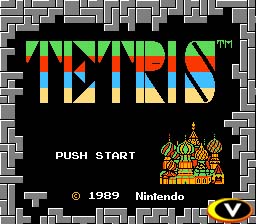
NES title screen.
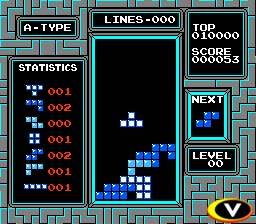
NES.
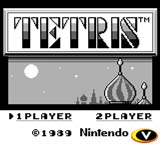
Game Boy title screen.
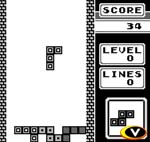
Game Boy.
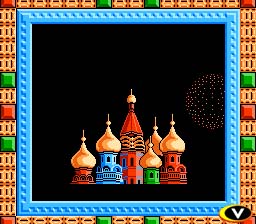
Tengen title screen.
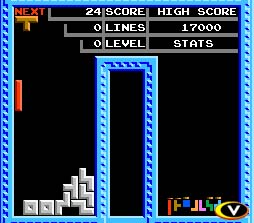
Tengen's version.
3a. Tetris (original)
Released: 1988, 1989
Systems: Arcade ('88), NES, Game Boy ('89)
Did the Game Boy make Tetris popular, or was it the other way around? Either way, the Game Boy was the way most people were introduced to Tetris. Some of us may have played it first at the arcade or on the Commodore 64, but it was Nintendo's decision to make it the pack-in game for the Game Boy that made Tetris a household name.
The arcade version, released by Atari Games, is broken down into levels, where you have to complete a certain number of lines to move on. And two players can play at once.
Tengen (Atari Games' home division) planned and produced an NES version of the coin-op without actually securing rights to the game. So, Nintendo game along, got the rights, and forced Tengen to take its version of the game off the market, but not before a few gamers had gotten their hands on a copy. Hence, Tengen's version of Tetris is one of the harder-to-find NES games.
In
both Nintendo's NES and Game Boy versions, there are two game
variations - the A Game, where the object is to complete the
most lines, and the B Game, where you try to complete 25 lines.
Other game options include nine levels of speed and the ability
to start the B Game with up to five levels of incomplete lines
already in the game area. One featuring missing from Nintendo's
NES version is two-player simultaneous play, which Tengen's version
includes.
3b. Tetris-klonen en -varianten
(plaatjes, verschillen..)
wordtris, columns, dr mario. tetrisblast, tetrisphere, tetris
attack, tetris plus, tetris64, tetris dx, magical tetris challenge,
tetris 4d, the new tetris, the next tetris.
4. Na Tetris (1989-1994)
After the wild success of Tetris, gamers wanted to get their
hands on a piece of the puzzle-game pie. A new genre had been
formed almost overnight, and developers rushed to get their products
to market. Although every system had its share of puzzle games,
the Game Boy was a particularly attractive dumping ground.
Some Post-Tetris games, like Bust-A-Move, Mario's Picross, and Columns, were able to escape the shadow of Tetris and become classics in their own right; others, like Pac-Attack and Wetrix, failed to grab the public's attention.
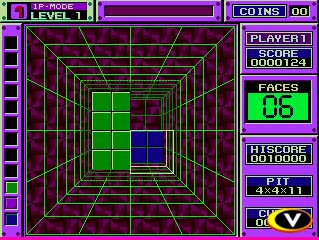 4a.Block
Out
4a.Block
Out
Released: 1989
Systems: Arcade
Block
Out is basically Tetris viewed from a top-down perspective, which
means you can't see what the hell you're doing. The goal here
is to complete 3D layers of blocks rather than two-dimensional
lines.
The problem is that there is no sense of depth as you look down into the well, so trying to correctly place blocks is nearly impossible. You are able to rotate your pieces in three dimensions, but only in a confusing wire-frame view that makes it unclear what type of block you have and what position it is in. The only possible way this game could have succeeded is if you had been able to change your perspective of the well. But you can't.
This
is an interesting concept wasted on what could be the most unplayable
puzzle game ever.
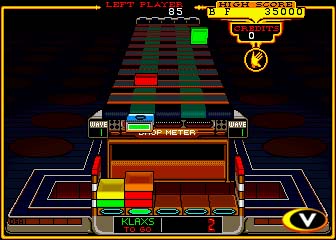 4b.Klax
4b.Klax
Released: 1989
Systems: Arcade, Atari Lynx, Sega Genesis, Game Boy, Game Boy
Color ('99)
In
Klax, a conveyor belt sends down colored tiles, and it's up to
you to arrange them into "klaxes" that is, rows of
three or more. You drop the tiles into a container that is five
tiles tall and five tiles across, and you can hold up to five
tiles on your paddle at once.
Every klax you make disappears. Vertical klaxs are worth 50 points,
horizontal klaxs are worth 1,000, and diagonal klaxs are worth
5,000. The game is divided into waves, and each wave has a specific
goal, such as making three klaxes, earning 10,000 points, or
surviving 50 tiles. If you let a tile slip by you, it drops into
the abyss. You are allowed three drops.
At first, Klax seems straightforward, but the more you play, the more there is to discover - like the advantages of stacking multiple tiles on your paddle or how to set up more than one klax at a time. Soon, the tiles are speeding down the conveyer belt so fast you almost don't have time to think. But that's what makes it fun.
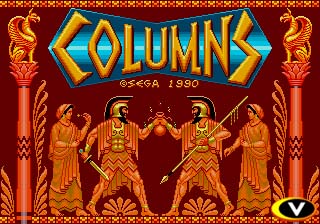 4c. Columns
4c. Columns
Released: 1990
Systems: Arcade, Sega Genesis, Game Gear
Columns,
Sega's answer to Tetris, is an exquisite puzzle game with a simple
premise, easy-to-learn rules, and extremely addictive gameplay.
Jewels are falling from the sky in vertical rows of three. These
columns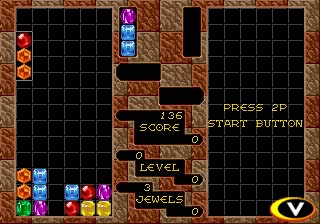 of jewels cannot be rotated, but you can
change their order. The object is to form rows of three or more
same-colored jewels. These rows can be either horizontal, vertical,
or diagonal. Once a row is formed, it disappears, and other jewels
fall to fill in the gaps. Depending on the difficulty setting,
there can be anywhere from four to six colors of jewels. As in
Tetris, if the jewels reach the top of the screen, the game is
over.
of jewels cannot be rotated, but you can
change their order. The object is to form rows of three or more
same-colored jewels. These rows can be either horizontal, vertical,
or diagonal. Once a row is formed, it disappears, and other jewels
fall to fill in the gaps. Depending on the difficulty setting,
there can be anywhere from four to six colors of jewels. As in
Tetris, if the jewels reach the top of the screen, the game is
over.
Columns contains three modes of play: arcade, original, and flash.
Arcade is standard Columns, as seen in the arcade; original is
the same as arcade but with more customizable options; and flash
consists of solvable puzzles that require you to clear the screen
of a specific jewel buried at the bottom of the screen as quickly
as possible. Each of these modes can also be played by two players
simultaneously.
One of the most satisfying parts of Columns is creating combos. One well-placed jewel can lead to a large chain reaction of disappearing jewels. Other notable aspects of the game are its music and visual look. Both are polished and classy, as opposed to the simplistic or cutesy music and look in some other puzzle games.
Although
it undoubtedly owes its existence to Tetris, Columns is an original
creation - its use of colors, chain reactions, and solvable puzzles
sets it apart as a true classic.
&Columns2.
4d.
Dr. Mario
Released: 1990
Systems: NES, Game Boy
After
saving the world a few times, Mario decided he was too important
to be just another plumber. So, he hit the books, studied hard,
and earned his medical degree. And just in time, too - a group
of nasty viruses has appeared, and it's up to you and Dr. Mario
to stop them.
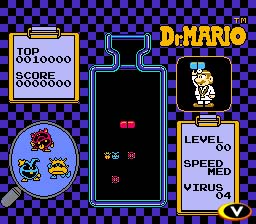
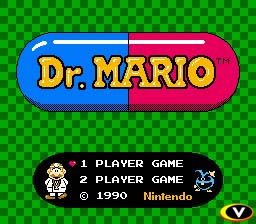
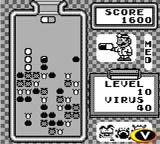
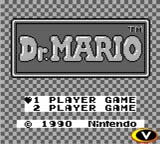
There are three types of viruses - red, yellow, and blue (or
black, white, and gray on the Game Boy) - and three matching
colors of pills to fight them. The Mushroom Kingdom must not
be very strict about giving out medical degrees because Mario
is an inept doctor at best. He just throws out random colored
pills like a demented pharmacist and leaves it up to you to do
the fighting.
Each pill is made up of two segments, each containing a single color. You must align at least three pill segments in a row next to a virus of the same color in order to kill the virus. The virus, as well as the pill segments, will then disappear. You can also match four same-colored pills in a row to make them disappear. When you kill every virus on the screen, you move to the next level.
At first glance, Dr. Mario seems like just another Tetris clone. But on further examination (pun intended), you'll realize it's almost nothing like Tetris. Each level has a definite end, and matching up lines of pills will get you nowhere. Dr. Mario also requires more strategy since you'll need to think a few steps ahead to solve each level.
Diagnosis? Dr. Mario is the cure for Tetris fever.
4e. Ishido: The Way of Stones
Released: 1990
Systems: Sega Genesis, Game Boy, Atari Lynx
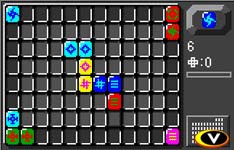 The object of Ishido is to rid yourself of
all your stones by making matches on the game board. Each stone
contains one of six symbols and one of six color combinations.
Stones are played on the board by placing them next to adjacent
stones of the same color or symbol. Multiple matches with two
or more stones can only be made if both the color and symbol
match. Your score is based on the number of matches you make,
and double points are awarded for two-, three-, and four-way
matches.
The object of Ishido is to rid yourself of
all your stones by making matches on the game board. Each stone
contains one of six symbols and one of six color combinations.
Stones are played on the board by placing them next to adjacent
stones of the same color or symbol. Multiple matches with two
or more stones can only be made if both the color and symbol
match. Your score is based on the number of matches you make,
and double points are awarded for two-, three-, and four-way
matches.
Ishido contains no time limit and rewards heavy contemplation
rather than twitch action.
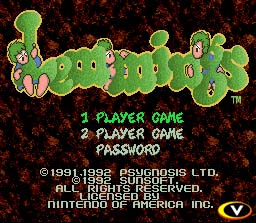 4f. Lemmings
4f. Lemmings
Released: 1992
Systems: Sega Genesis, SNES, Game Boy, Game Gear, Sega Master
System
In
the real world, lemmings are small rodents that follow each other
blindly to their deaths. In the video-game world of Lemmings,
they behave in much the same way, but it's up to you to save
them from perishing.
Each level of Lemmings has a certain number of lemmings fall
from an opening in the sky.They head mindlessly in one direction,
unaware that they are about to drown, fall, or be burned. It's
your job to guide them s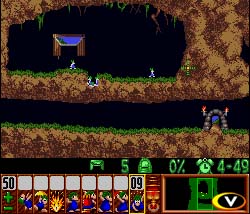 afely to each level's
exit by putting their innate skills to use. Each lemming can
be turned into one of eight types - climber, floater, bomber,
blocker, builder, basher, miner, or digger. For example, to stop
a group of lemmings from falling into the water, you can turn
one into a blocker to serve as a barricade. Or you might have
to float the lemmings off a cliff by turning them into floaters.
afely to each level's
exit by putting their innate skills to use. Each lemming can
be turned into one of eight types - climber, floater, bomber,
blocker, builder, basher, miner, or digger. For example, to stop
a group of lemmings from falling into the water, you can turn
one into a blocker to serve as a barricade. Or you might have
to float the lemmings off a cliff by turning them into floaters.
A
certain percentage of lemmings, ranging from 10 to 100 percent,
must be saved in each level, and you are given a limited number
of lemming transformations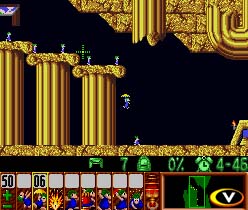 per skill depending
on the setup of that particular level.
per skill depending
on the setup of that particular level.
The game's learning curve is tailored to introduce new players to each skill and to how it works. Knowledge of the timing and process of each skill is necessary for you to solve each obstacle course-like level. As in most puzzle games, the earlier levels are simple to complete, but the later levels take hours of trial and error (and sometimes luck) to finish.
Lemmings
is sometimes mind-numbingly difficult, but its ingenious premise,
cute graphics, and addictive gameplay make it enormously fun.
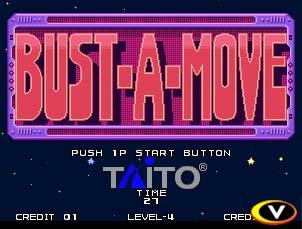 4g.
Bust-A-Move
4g.
Bust-A-Move
Released: 1994, 1995
Systems: Arcade - Neo Geo ('94), SNES, Game Gear ('95)
Who
could've guessed one of the most popular series of puzzle games
would get its start on the Neo Geo, a superpowered 16-bit system
previously known mostly for fighting games like Samurai Showdown
and Fatal Fury? The Neo Geo was unique in that the exact same
games used in the arcade could be played on the home 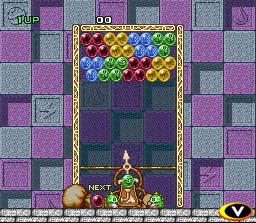 version
of the system. Although its high price kept it from seriously
competing with the Genesis or SNES, its popularity in the arcades
has kept it alive well into the late '90s.
version
of the system. Although its high price kept it from seriously
competing with the Genesis or SNES, its popularity in the arcades
has kept it alive well into the late '90s.
The object of Bust-A-Move is to remove the colored bubbles clustered
at the top of the screen. At the bottom of the screen is a randomly
colored bubble, which you must aim at the cluster. You can aim
directly at other bubbles or bounce them off the walls like billiard
balls on a pool table.
When you get three bubbles of the same colorto touch each other,
they will fall and disappear, along with any other bubbles attached
to them. These chain reactions arevital to the game; one well-placed
bubble shot can often clear an entire stage. As a time limit,
the cluster will lower by one level every so often. If a bubble
reaches the bottom of the screen, the game is over.
What makes it so good? As one of the few puzzle games that doesn't bear any relation to Tetris, Bust-A-Move took puzzle games in a completely new direction, showing there was room for innovation in a genre famous for its reluctance to stray from the formula. Bust-A-Move's lasting success is due to its simple concept, fast-paced action, and extremely addictive gameplay. It's also one of the best multiplayer puzzle games out there. And most importantly, it's just as fresh and exciting today as it was when it first came out.
&Puzzle
Bobble 2, 3, 4, '99, move again..
5 Voorbij Tetris (vanaf 1995)
As video-game systems grew more advanced in the second half of
the '90s, puzzle games stayed firmly rooted in the past. With
a few notable exceptions, like Intelligent Qube, Mario's Picross,
and Devil Dice, the genre has been dominated by Tetris and Bust-A-Move
variations and sequels.
5a. Mario's Picross
Released: 1995
Systems: Game Boy
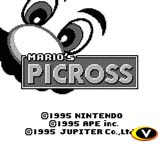 A mix between a crossword puzzle, a numbers
game, and Minesweeper, Mario's Picross is played on grids of
various sizes, from 5-by-5 on the early levels to 15-by-15 on
the most difficult. The object is to reveal a picture by filling
in squares on the grid. On the horizontal and vertical axes of
each grid line is a number or series of numbers representing
the number of squares to be filled in on that row or column.
Each puzzle has a time limit of 30 minutes, and time is taken
away for every wrong square you try to fill in.
A mix between a crossword puzzle, a numbers
game, and Minesweeper, Mario's Picross is played on grids of
various sizes, from 5-by-5 on the early levels to 15-by-15 on
the most difficult. The object is to reveal a picture by filling
in squares on the grid. On the horizontal and vertical axes of
each grid line is a number or series of numbers representing
the number of squares to be filled in on that row or column.
Each puzzle has a time limit of 30 minutes, and time is taken
away for every wrong square you try to fill in.
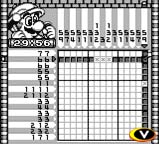 It might sound confusing, but it really isn't.
A quick in-game lesson clears up any questions, and once you
get started, the principles behind the game are easy to pick
up. The first few levels are also very basic, which gives you
time to get adjusted.
It might sound confusing, but it really isn't.
A quick in-game lesson clears up any questions, and once you
get started, the principles behind the game are easy to pick
up. The first few levels are also very basic, which gives you
time to get adjusted.
Mario's
Picross is the perfect puzzle game - it's easy to learn, addictive,
mentally stimulating, and always fun to play. It is a true thinking-person's
puzzle game, and with over 190 different puzzles to solve, it
will have you thinking for a long time.
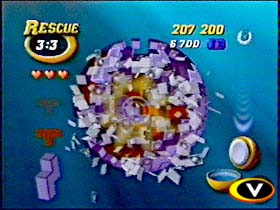 5b. Tetrisphere
5b. Tetrisphere
Released: 1997
Systems: Nintendo 64
Although a 3D Tetris-style game was attempted way back in 1989
with the horrendous Block Out, Tetrisphere truly takes Tetris
into the third dimension with enhancements that aren't merely
cosmetic. While it uses Tetris blocks, the game requires you
to remove pieces rather than build them up. In order to do this,
you drop and slide pieces on a multilayered, rotatable sphere,
with the goal of clearing a path to its core. A piece must be
dropped on or next to two or more pieces of the same shape; doing
so causes them to disappear.
Tetrisphere is definitely more complicated than Tetris and requires
a larger investment of time in order to learn how to play. But
once you do learn, the rewards are great. It's just as addictive
as Tetris, and it's loaded with different modes of play, including
a puzzle, a time trial, and a vs. computer mode, as well as a
hide-and-seek mode, which provides several different variations
on the same basic gameplay concept. Two players can also play
simultaneously.
With rich, colorful backgrounds, sharp polygon graphics, and
CD-quality music, the visual and auditory experience of Tetrisphere
is just as invigorating as its innovative gameplay, something
you can't say about most puzzle games. It is to be commended
for taking the Tetris name and actually doing something new with
it for a change.
5c. Devil Dice
Released: 1998
Systems: Sony PlayStation
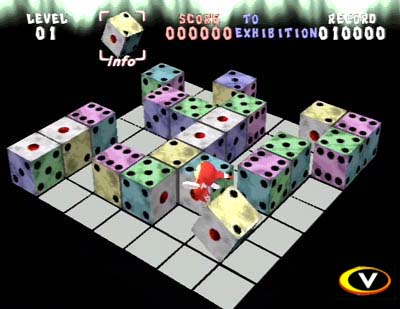
In Devil Dice, you control a small devil who lives on a grid
filled with dice. Each time you move a die, it rotates. The goal
is to match up dice according to the number on their face - two
twos, three threes, four fours, etc. - in order to remove them
from the grid, all while more dice are popping up around you.
Once the grid is completely filled with dice, the game is over.
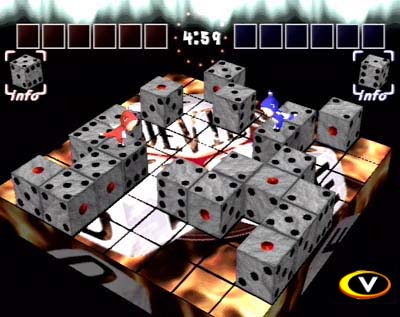
Up to five people can play at once with the multitap in war mode.
Also included is a puzzle mode in which you must solve dice puzzles
in a limited number of turns.
5d.
Wetrix
Released: 1998
Systems: Nintendo 64
It's hard
to describe just how bad Wetrix really is. We're talking really
bad.
The game requires you to arrange falling blocks onto a three-dimensional
board in such a way as to keep water droplets from building up
and flooding over the edge. In order to earn the most points,
blocks should be placed to create separate pools of water. In
addition to falling blocks and water, you also have to contend
with destruction blocks, earthquakes, and two types of bombs.
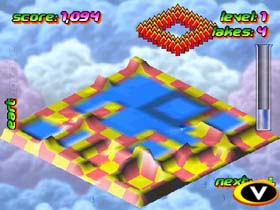
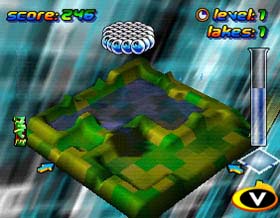
Unfortunately,
you also have to contend with sloppy controls, nonintuitive gameplay,
frustrating objectives, and awkward 3D viewpoints. Along with
Block Out and Puzznic, this ranks as one of the worst puzzle
games you'll come across.
5e. Hexcite
Geometry was never so fun.
Hexcite title screen.
Released: 1999
Systems: Game Boy Color
Played on a game board made of seven hexagons and divided into tiny triangles, Hexcite is a two-player game in which players place various geometric shapes on the board and gain points for their placement. After the first turn, a shape must be placed adjacent to another shape. You earn five points for each side your shape is touching. If you fill an entire hexagon, you earn bonus points. Gameplay continues until all your shapes are gone or you can no longer make a move.
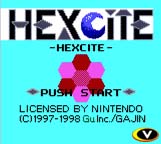
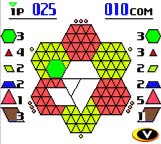
After playing for several rounds, Hexcite takes on the atmosphere
of a good chess game - you start planning several moves in advance,
hoping your opponent doesn't block your strategy, and the pace
of the game depends on the players.
An in-game tutorial makes Hexcite easy to learn, but having several different levels of computer opponents keeps the game challenging.
Hexcite may be a newcomer to the puzzle-game world, but it's already a classic in my book.
gecompileerd door: michael + pi voor dvtg14 games genres
bronnen: gamespot.com, trigger happy